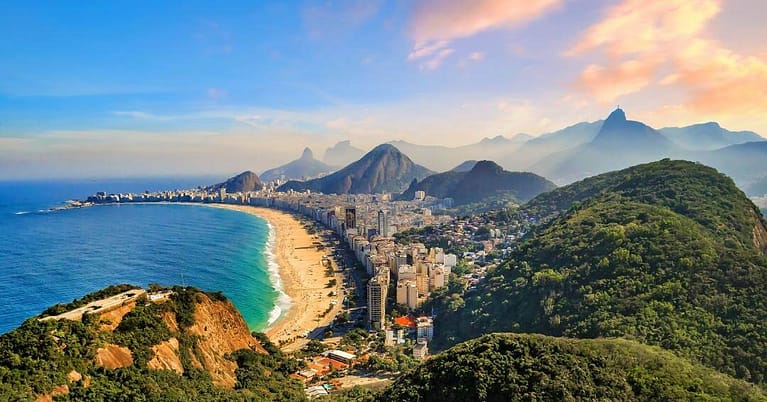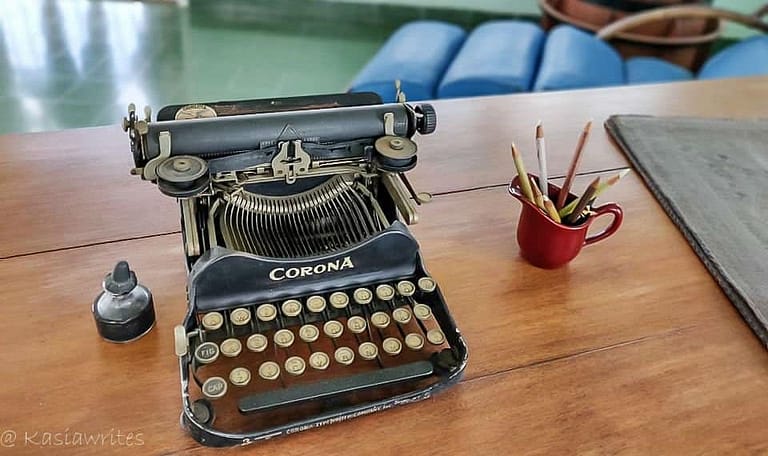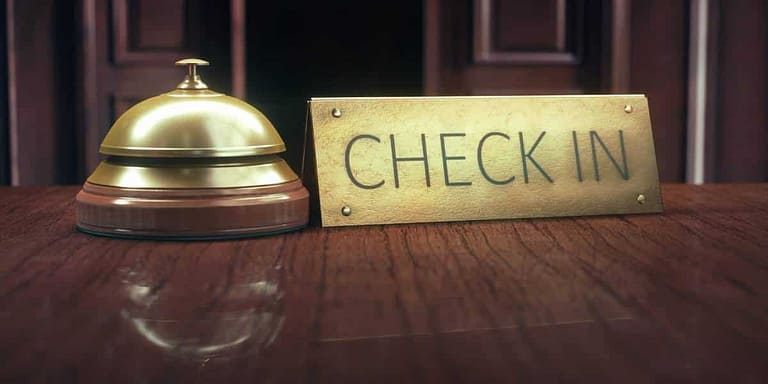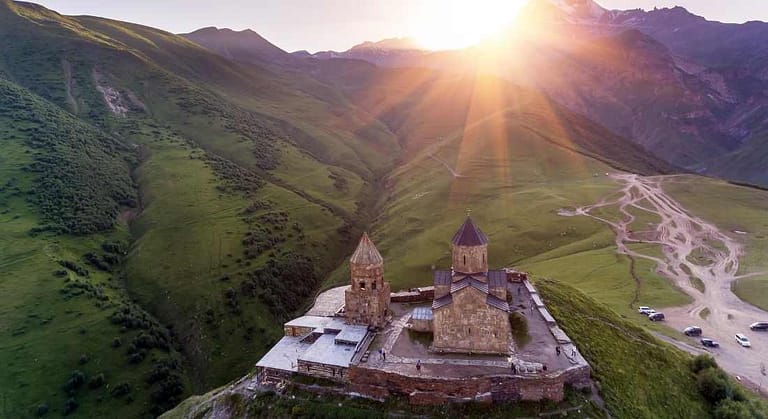Death & Devotion: Exploring Catacombs of Early Christians in Rome
One of my favourite things about Rome is that it’s like a layered cake. Each layer tells a different story, and the further down you go, the more interesting it gets. While most people come to Rome to marvel at the Colosseum, admire the art at the Vatican Museums or toss a coin in the Trevi Fountain, there is another side of the Eternal City that most people never see.
I recently had an opportunity to explore the darker side of the city and its hidden history with a tour of Rome’s catacombs and bone crypts. From a stop by a church adorned with skeletons, skulls and bones to navigating the burial chambers of the early Christians and exploring the bone-decorated crypts of the Capuchin monks, this is a journey like no other. Want to know more about the early Christians of Rome? Then this tour is a must for you.
Affiliate Disclosure – This post contains affiliate links. If you make a purchase through these links, I may earn a commission. This doesn’t affect your purchases or any fees you may pay for the product or service. Read more in my DISCLAIMER.
Life and death in early Christian Rome
In the past, life wasn’t easy, and death was a common occurrence. Early Christians not only faced persecution for their beliefs, but they also had to deal with violence, disease and limited medical care. They navigated life with a deep reliance on faith, using it as an anchor in the tumultuous reality.
Early Christians held a different perspective on death than we do today. Death was not an end but a passage, a transition to a promised eternal life. As such, their buildings, especially those of a religious nature, art and beliefs, reflected those ideas. If you know where to look, you will find this iconography all over the city, and it will challenge your perceptions of life, death, and everything in between.
There is no better way to explore the eerie yet fascinating world of death and mortality in early Christian Rome than by visiting the catacombs and crypts beneath the ancient city streets. To make the most of your experience and make sense of what you’re seeing, I recommend taking a tour where a guide will explain all the fascinating and sometimes macabre things you find along the way.
Crypts, Bones and Catacombs: An Underground Tour of Rome
While most people associate Rome with the ancient empire, there is another part of the city that’s not always explored beyond the Vatican. The Vatican City, in the heart of Rome, is home to the pope and the Catholic church. But there is much more to the city’s early Christian inhabitants that tells a story of survival and perseverance.
The Sanctity of Santa Maria dell’Orazione e Morte
My tour with Walks started with a stop at the Church of Santa Maria dell’Orazione e Morte, also known as St. Mary of Prayer and Death, in the historic via Giulia. At first glance, this looks like any other ornate church until you stop and look at its facade adorned with skulls. There is also a skull and an inscription above the entrance, Hodie mihi, cras tibi (Today me, tomorrow you), which serves as a stark reminder of death’s inevitability.

The church, dedicated to the forgotten dead, was founded in the 16th century by the Brotherhood of Prayer and Death. At the time, there was a growing issue with abandoned corpses (yes, you read that right) and the brotherhood took on the responsibility of collecting these forgotten bodies and providing them with a dignified burial. If you think your job is bad, think of these volunteers who went out every day, looking for dead bodies on the streets. I can’t even begin to imagine what that was like.
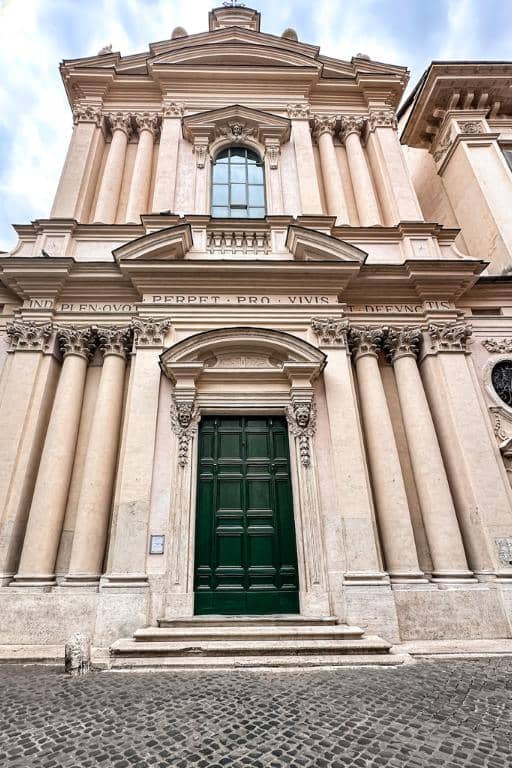
Why were there so many dead lying around, you might ask. Poverty and lack of public cemeteries meant that many couldn’t afford or access proper burials. The poor, sick and forgotten often remained where they died or were left there by their families who were unable to bury them. Then, there were those who either drowned or were thrown into the Tiber River. They were all brought to the cemetery that was behind the church and buried.
Over time, as they ran out of space, the church was expanded to accommodate the piling bodies. Eventually, with the expansion of the Tiber walls, the cemetery was destroyed to make room for the supporting walls and the remains were moved to a crypt under the church. They collected over 8,000 corpses over the centuries and used the bones as decoration. Yikes. You can visit the crypt if you want that full experience, but on this tour, you’ll get plenty of it later on.
Exploring Rome’s catacombs
Our next stop was the catacombs. There are over 60 catacombs in Rome, with some rediscovered only recently. While that’s significant, only a few are open to the public. To see them, we enjoyed a comfortable ride along the Via Appia, one of the oldest Roman roads dating back to 300 BC. If you don’t think too much about the layers and layers of burial grounds underneath, it’s quite a nice ride.

What exactly are the catacombs? They are underground burial sites that also functioned as clandestine meeting spaces for persecuted Christians. They were basically underground cemeteries that functioned as resting places for the deceased and a refuge for those who had to practice their faith away from prying eyes. These passages were carved out of soft tufa rock. Even the name “catacombs” is likely derived from the Greek phrase “kata kumbas,” meaning “near the hollows” or “by the quarry.”

We visited the San Sebastian catacombs, the oldest catacombs in Rome, dating back to the 3rd century AD. They are pretty impressive, with about 12 km of tunnels over three floors underground. You had three options for burial here. The first is a simple niche recessed into the wall where a body wrapped in sheets was placed and then covered with a marble or brick cover. The second was a larger space where you could have several of these shelves.
The third option was more like a room with even more spaces for niches where bodies could be laid to rest. These were used by wealthy families. While most of the remains have been removed to prevent people from stealing them (like, what?), and I would guess for sanitary reasons, one tomb is still sealed, so you can see the description and what it would have looked like.

We also stopped by what was the entrance to the quarry that early Christians also used as the entrance to the catacombs. Here you can see the pre-Christian necropolis that Romans used for their dead long before. There are three entrances that you look down on, but they are closed off, so you can’t venture down there. Even from the entrance, you can see the ornamentation and frescoes that distinguish them from the plainer Christian ones. The necropolis was eventually covered up and rediscovered in 1922. That is pretty cool.

The visit ends inside the Basilica of St Sebastian Outside the Walls (San Sebastiano Fuori le Mura), which stands above the catacombs. It was initially constructed in the 4th century AD on the order of Emperor Constantine. In 1608, Cardinal Scipione Borghese oversaw its renovation and the facade we see today dates back to that time. Inside, you can admire the carved wooden ceilings, several chapels created by various noble families and Bernini’s last sculpture. Noteworthy are the Chapel of Relics, where you can see stone imprints said to belong to Jesus, the Albani Chapel and the St. Sebastian Chapel.
The Capuchin Crypt: A Sanctuary of Bones
The next and last stop of the tour was the Capuchin Crypt. From the outside, the Church of Our Lady of the Immaculate Conception looks like another church in Rome. I’ve often walked by it and haven’t thought much about it. What I didn’t know is that inside is another world filled with human bones. Literally.
The Capuchin Crypt is located beneath the 17th-century church. Inside is a museum story of the Capuchin monks and numerous images and objects from the past that tell the story of the order. Once you get through the standard-museum-design space, you enter the famous bone crypts.
When the monks moved here, they brought with them the remains of the other dead monks. They had to do something with them, so they somehow decided to decorate their new digs with the remains of others. It’s a concept my 21st-century brain can’t comprehend.

It just shows you how different the approach to dealing with death and the dead has changed. What looks to me more like a den of a deranged serial killer-turned-interior-designer to the monks was an expression of devotion. The bones serve as the concept of memento mori, a Latin phrase meaning “remember you must die.”
There are several small chapels decorated with the bones of over 3,700 people. The chapels have different themes, including the Crypt of the Skulls, Crypt of the Pelvises, Crypt of the Leg Bones and Thigh Bones, to give you an idea of the decor.
These aren’t bones and skulls piled in a corner, mind you, but an artistic, and yes, slightly creepy, display of human remains. Think skeletal figures arranged in niches, elaborate chandeliers crafted from femurs and vertebrae, and even entire skeletons clothed in Capuchin robes, eternally posed in prayer. The intricate bone arrangements, with their geometric patterns and draped robes, showcase a surprising level of artistry and devotion. It’s a testament to the Capuchins’ belief in the afterlife, where the physical body, though displayed in such an unusual way, is still a holy vessel.
Final thoughts on the Crypts, Bones and Catacombs tour
As a history buff and cultural explorer, I found this tour fascinating. While the way people lived in the past might seem different from today, many of their ideas and perceptions of life and death have influenced how we view it today. Many people come to Rome seeking different experiences. Whether you’re here for the food, the ruins, or a religious pilgrimage, the Eternal City delivers.
If you’re looking for an experience that goes beyond the usual tourist fare, then this tour is for you. Not only will you get a glimpse into the past, but you’ll also have an opportunity to learn about the people who lived and died here. As you’ll learn, for many, death was only the beginning. Just be prepared for a thought-provoking encounter with death, a touch of the macabre, and a way to confront death, a far cry from the sterile modern cemetery.
Disclosure: I was invited to this by Walks Tours, however, all opinions shared here are my own.


